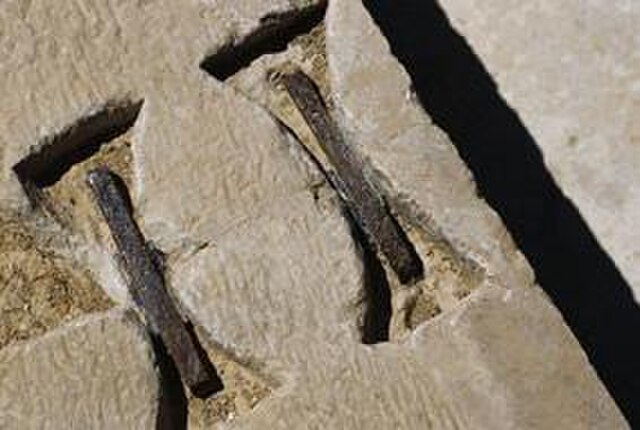Pasargadae /pə'sɑrgədi/ was the capital of the Achaemenid Empire under Cyrus the Great. Today it is an archaeological site located just north of the town of Madar-e-Soleyman and about 90 kilometres (56 mi) to the northeast of the modern city of Shiraz. It is one of Iran's UNESCO World Heritage Sites. It is considered to be the location of the Tomb of Cyrus, a tomb previously attributed to Madar-e-Soleyman, the "Mother of Solomon". Currently it is a national tourist site administered by the Iranian culture of world heritage.
Tomb of Cyrus the Great in Pasargadae
View of Pasargad from Toll-e Takht hill. The closest building to the tomb attributed to Cambyses II and the farthest building that can be seen in the center of the upper part of the image is the Tomb of Cyrus the Great. Between these two buildings, the ruins of Achaemenid palaces can be seen.
"I am Cyrus the king, an Achaemenid." in Old Persian, Elamite and Akkadian languages. It is carved in a column in Pasargadae
Dovetail Staples from Pasargadae
Cyrus II of Persia, commonly known as Cyrus the Great, was the founder of the Achaemenid Persian Empire. Hailing from Persis, he brought the Achaemenid dynasty to power by defeating the Median Empire and embracing all of the previous civilized states of the ancient Near East, expanding vastly and eventually conquering most of West Asia and much of Central Asia to create what would soon become the largest polity in human history at the time. The Achaemenid Empire's largest territorial extent was achieved under Darius the Great, whose rule stretched from the Balkans and the rest of Southeast Europe in the west to the Indus Valley in the east.
"Winged Genius" statue at Pasargadae, with braided hair and a Hemhem crown, traditionally identified as Cyrus
The four-winged guardian figure that may depict Cyrus, known from a bas-relief on a doorway pillar from Pasargadae. An inscription says "I am Cyrus the King, an Achaemenian." Scholars doubting the relief depicts Cyrus note the inscription was inscribed in a later period and that the same inscription is found on other palaces in the complex.
"I am Cyrus the King, an Achaemenian" in Old Persian, Elamite and Akkadian languages. It is known as the "CMa inscription", carved in a column of Palace P in Pasargadae. These inscriptions on behalf of Cyrus were probably made later by Darius I in order to affirm his lineage, using the Old Persian script he had designed.
Painting of king Astyages sending Harpagus to kill young Cyrus








